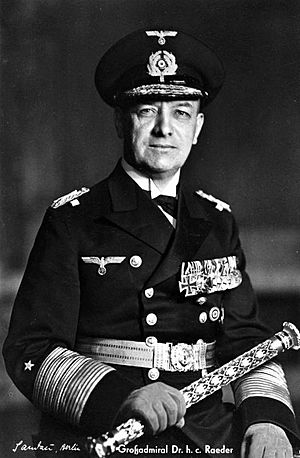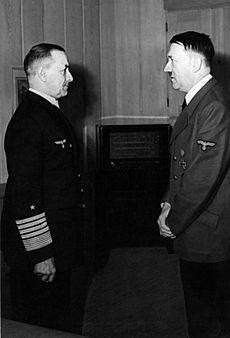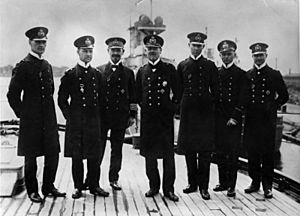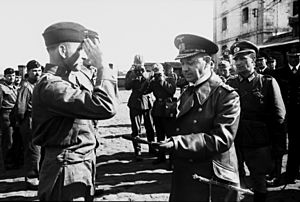Erich Raeder facts for kids
Erich Johann Albert Raeder (born April 24, 1876 – died November 6, 1960) was a German admiral who played a big part in the naval history of World War II. He reached the highest rank in the navy, grand admiral, in 1939. Raeder led the German navy, called the Kriegsmarine, for the first half of World War II. He left his position in January 1943 and was replaced by Karl Dönitz. After the war, at the Nuremberg Trials, he was sentenced to life imprisonment but was released early because he was very sick.
Quick facts for kids
Großadmiral
Erich Raeder
|
|
|---|---|
 |
|
| Oberbefehlshaber der Marine | |
| In office 1 June 1935 – 30 January 1943 |
|
| Deputy | Rolf Carls |
| Preceded by | Himself (as Head of the Naval Command) |
| Succeeded by | Karl Dönitz |
| Head of the Naval Command | |
| In office 1 October 1928 – 1 June 1935 |
|
| Preceded by | Hans Zenker |
| Succeeded by | Himself (as Oberbefehlshaber der Marine) |
| Personal details | |
| Born |
Erich Johann Albert Raeder
24 April 1876 Hamburg, German Empire |
| Died | 6 November 1960 (aged 84) Kiel, Schleswig-Holstein, West Germany |
| Resting place | Nordfriedhof cemetery, Kiel |
| Spouse | Augusta Schultz |
| Children | 4 |
| Parents | Hans Friedrich Eduard Raeder (father) Gertrud Wilhelmine Margaretha (mother) |
| Signature |  |
| Military service | |
| Allegiance |
|
| Branch/service |
|
| Years of service | 1894–1943 |
| Rank | |
| Commands | SMS Cöln |
| Battles/wars | World War I World War II |
| Awards | |
| Criminal conviction | |
| Criminal status | Deceased |
| Conviction(s) | Conspiracy to commit crimes against peace Crimes of aggression War crimes |
| Trial | Nuremberg trials |
| Criminal penalty | Life imprisonment |
Contents
Erich Raeder was born in Wandsbek, a town in what was then the German Empire. His father was a headmaster, a strict teacher and parent. He taught Erich the importance of hard work, saving money, faith, and obedience. These were values Raeder believed in his whole life.
Raeder joined the Kaiserliche Marine (Imperial Navy) in 1894. He quickly moved up in rank. By 1912, he became the chief of staff for Franz von Hipper, a well-known admiral. Raeder was smart and worked very hard. From 1901 to 1903, he worked for Prince Heinrich of Prussia, which helped him gain powerful connections.
In 1904, Raeder, who spoke Russian fluently, went to the Far East. He observed the Russo-Japanese War there. Later, he worked in the Navy's public relations. He met Admiral Alfred von Tirpitz, who was a very important figure in the Navy. Tirpitz wanted Germany to build a strong navy to become a "world power." Raeder helped Tirpitz convince politicians to pass laws to build more battleships.
Before World War I, Raeder was the captain of Kaiser Wilhelm II's private yacht. This job often led to quick promotions.
World War I Service
During World War I, Raeder served as Admiral Hipper's chief of staff. He also took part in battles. He was involved in the Battle of Dogger Bank in 1915 and the Battle of Jutland in 1916. Hipper did not like paperwork, so he gave Raeder a lot of power. This meant Raeder had more influence than his job title suggested.
During the Battle of Jutland, Raeder played a key role in planning a raid. This raid aimed to draw out British ships so the main German fleet could destroy them. During the battle, Raeder had to move from one ship, SMS Lützow, to another, SMS Moltke, because his ship was damaged.
After the war, on October 14, 1918, Raeder was promoted to deputy to Admiral Paul Behncke. He spent the last weeks of the war working on a plan to build many submarines.
On October 28, 1918, the German fleet had a mutiny. Raeder worked hard to stop this uprising.
Weimar Republic Years
After World War I, Raeder faced personal challenges. His two younger brothers died in the war. In 1919, his first marriage ended. This was a very difficult time for him.
In 1918–1919, Raeder helped naval officers try to end the sailors' councils that formed after the mutiny. He worked with the Defense Minister, Gustav Noske. Raeder suggested that Adolf von Trotha become the new commander-in-chief of the Navy. The Navy also helped put down Communist uprisings. In return, the Navy kept its special status and avoided attempts to make it more democratic.
Kapp Putsch and Promotion
In 1920, Raeder was involved in the failed Kapp Putsch, a coup attempt against the Weimar Republic. He, along with most naval officers, supported the coup leaders. After the coup failed, he was moved to the Naval Archives. For two years, he helped write the official history of the Navy in World War I.
After this, Raeder continued to rise in the navy. He became a vice admiral (Vizeadmiral) in 1925. On October 1, 1928, Raeder was promoted to admiral and became the chief of the Naval Command (Chef der Marineleitung) of the Reichsmarine, which was the Weimar Republic's navy.
On June 1, 1935, the Reichsmarine was renamed the Kriegsmarine. Raeder became its commander-in-chief, with the title Oberbefehlshaber der Kriegsmarine. On April 20, 1936, Raeder was promoted to the new rank of Generaladmiral. He was given the power of a government minister. On January 30, 1937, Adolf Hitler gave Raeder a special award, which made him a member of the Nazi Party.
World War II Leadership
Raeder believed the German navy was not ready for World War II. He thought it needed at least five more years to prepare. The surface fleet was too small to fight the powerful Royal Navy. So, Raeder decided on a strategy of attacking enemy convoys (groups of merchant ships). He wanted the Kriegsmarine to be active so its budget would not be cut after the war. Smaller German ships were sent around the world to make the Royal Navy spread out its forces. Battleships would attack in the North Sea to slowly weaken the Royal Navy.
Raeder was unhappy with the outcome of the Battle of the River Plate. He believed that Hans Langsdorff should not have sunk his ship, but instead fought the Royal Navy. Raeder then ordered that German ships must fight until they ran out of ammunition, and either win or sink with their flags still flying.
Norway Invasion
The Allies were using Norwegian airfields to send planes to Finland, which was fighting the Soviets. They were also placing mines in Norwegian waters. Germany was worried because this could cut off their important iron ore imports from Sweden. If the Allies used Norwegian naval bases, they could also tighten their blockade of Germany.
Admiral Rolf Carls suggested invading Norway to Raeder in September 1939. Raeder told Hitler about the idea in October. Planning for the invasion began in December 1939. The plan became urgent after the Altmark incident in February 1940. In this event, British sailors freed Allied prisoners from a German ship in neutral Norwegian waters.
The invasion of Norway was costly for the Kriegsmarine. It lost many ships, including a heavy cruiser, two light cruisers, ten destroyers, and six U-boats. Most other large ships were damaged and needed repairs. For a time, the German surface fleet had very few ships ready for action.
Atlantic Operations
Germany's quick victory over France allowed the Kriegsmarine to use ports on France's west coast. This was very important. German warships no longer had to go through the dangerous English Channel to return home. They could also go further into the Atlantic to attack convoys.
After France surrendered, Raeder wanted to take over the ships of the French Navy. He thought this would greatly increase Germany's naval power. However, Hitler said no. He was afraid that taking the French ships would make the French Navy join the Royal Navy. The British were worried about Raeder's plan. This led to the Attack on Mers-el-Kébir, where the Royal Navy attacked the French Navy, even though they were at peace.
In July 1940, Hitler and Raeder agreed to continue building the battleships planned in Plan Z. Raeder also had naval bases built in Norway and France. At this time, Raeder and other senior officers suggested invading many places, including Iceland and Madagascar.
In January 1941, the battlecruisers Scharnhorst and Gneisenau had a successful mission. They attacked merchant ships in the Atlantic. In March, Raeder wanted to start attacking US warships, even without being provoked.
In April 1941, Raeder planned an even bigger mission called Operation Rheinübung. It was meant to follow up on the success of Scharnhorst and Gneisenau. The original plan included two battlecruisers, but they were damaged. So, only the battleship Bismarck and the cruiser Prinz Eugen were sent. This mission ended with the sinking of the Bismarck. This event almost stopped the use of large ships against merchant shipping. Hitler was not happy and thought building and operating the Bismarck was a bad investment.
In late 1941, Raeder planned the Channel Dash. This involved sending the remaining two battleships from French ports back to Germany. The goal was to threaten supply convoys to the Soviet Union and keep British ships busy in the North Sea.
After the attack on Pearl Harbor, Raeder, along with other top military leaders, urged Hitler to declare war on the United States right away. They wanted to start U-boat attacks off the US east coast.
Raeder's Resignation

On January 30, 1943, Hitler was very angry about the Battle of the Barents Sea. Raeder had not told Hitler about the battle, and Hitler learned about it from foreign newspapers. Hitler thought the German ships in the battle did not fight hard enough. Because of this, Karl Dönitz, the commander of the Kriegsmarine's U-boat force, was promoted to grand admiral. Raeder was given a ceremonial job as admiral inspector.
After World War II
Nuremberg Trial and Release
Soviet troops captured Raeder on June 23, 1945. He was held in Moscow. In late July, he was taken to Nuremberg to stand trial. He was accused of:
- Planning and starting wars of aggression.
- Committing crimes against the laws of war.
Raeder was found guilty of these charges. He was sentenced to life imprisonment. He was surprised by this, as he had expected to be sentenced to death. His wife and German veterans worked to get him released. Because of his poor health, he was set free on September 26, 1955.
Later Life
After his release, Raeder wrote his autobiography, Mein Leben (My Life). He died in Kiel on November 6, 1960. His wife had passed away in 1959. He is buried in the Nordfriedhof (North Cemetery) in Kiel.
Dates of Rank
- Sea cadet: April 26, 1894
- Midshipman: May 13, 1895
- Sub-lieutenant: October 25, 1897
- Lieutenant: around 1900
- Lieutenant-commander: around 1905
- Commander: April 15, 1911
- Senior commander: around 1915
- Captain: November 19, 1919
- Rear admiral: August 1, 1922
- Vice admiral: April 1, 1925
- Admiral: October 1, 1928
- General admiral: April 10, 1936
- Grand admiral: April 1, 1939
Key Awards and Decorations
- Iron Cross (1914) 2nd Class (November 19, 1914) & 1st Class (February 18, 1915)
- Knight's Cross of the Royal House Order of Hohenzollern with swords (June 5, 1916)
- Cross of Honour (October 9, 1934)
- Golden Party Badge (January 30, 1937)
- Clasp to the Iron Cross, 1st and 2nd class (September 30, 1939)
- Knight's Cross of the Iron Cross (September 30, 1939)
See also
 In Spanish: Erich Raeder para niños
In Spanish: Erich Raeder para niños




